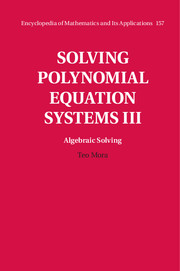Summary
La gloria di colui che tutto move
per l'universo penetra, risplende
in una parte piú meno altrove.
My HOPE that this SPES series reaches completion has supported me over many years. These years have been devoted both to fixing the details of the operative scheme based on Spear's Theorem, which allows one to set a Buchberger Theory over each effective associative ring and of which I have been aware since my 1988 preprint “Seven variations on standard bases” and to satisfy my horror vacui by including all the relevant results of which I have been aware.
My horror vacui had the negative aspect of making the planned third book grow too much, forcing me to split it into two separate volumes. As a consequence the structure I planned 12 years ago and which anticipated a Hegelian (or Dante–like) trilogy, whose central focus was the Gröbnerian technology discussed in Volume II, was quite deformed and the result appears as a (Wagner-like?) tetralogy.
This volume contains Part six, Algebraic Solving, and is where I complete the task set out in Part one by discussing all the recent approaches. These are mainly based on the results discussed in Volume II, which allow one to effectively manipulate the roots of a polynomial equation system, thus fulfilling the aim of “solving” as set out in Volume I according to the Kronecker–Duval Philosophy: Trinks’ Algorithm, the Gianni–Kalkbrener Theorem, the Stetter Algorithm, Dixon's resultant, the Cardinal–Mourrain Algorithm, Lazard's Solver, Rouillier's Rational Univariate Representation, the TERA Kronecker package.
Macaulay's Matrix and u-resultant, a historical tour of elimination from Bézout to Dixon, who was the last student of Cayley, the Lagrange resolvent and the investigation of it performed by Valibuze and Arnaudies are also covered.
Information
- Type
- Chapter
- Information
- Solving Polynomial Equation Systems III , pp. xi - xiiPublisher: Cambridge University PressPrint publication year: 2015
